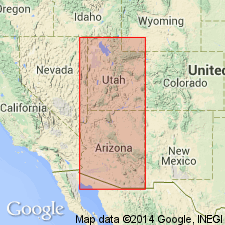
- Usage in publication:
-
- Toroweap formation
- Modifications:
-
- Named
- Dominant lithology:
-
- Sandstone
- Limestone
- Gypsum
- AAPG geologic province:
-
- Plateau sedimentary province
- Great Basin province
Summary:
Named for exposures (type section) on east wall of Toroweap Valley, Grand Canyon National Monument, about 9 mi above mouth and 8 mi north of Colorado River, Mohave Co, AZ, Plateau sedimentary province. Is 424.5 ft thick at type where it is divisible into members gamma, beta, and alpha that represent advancing sea (lower), extended sea (middle), and retreating sea (upper) deposits. At type consists of: 1) brown to gray, thin- to thick-bedded, sandy, fossiliferous limestone that weathers rounded, slope-forming to cliffy exposures; 2) red, yellow, white, fine-grained, calcareous, crumbly sandstone that weathers to rounded exposures; 3) blue chert; and 4) near top some thin black shale. Present in measured sections from Mule Spring Mountain, southeast NV and to Minersville, Beaver Co, UT in the Great Basin province, and across northern AZ as far east as Marble Canyon, Coconino Co, AZ in the Plateau sedimentary province. Cross sections. Ranges from 14 to 432 ft thick in measured sections. These rocks formerly assigned to the lower part, subdivisions C, D, and E of the Kaibab limestone. Facies discussed. Chemical analyses. Fossils (echinoids, crinoids, bryozoans, brachiopods, pelecypods, scaphopods, gastropods, crustaceans, fish remains). Of Middle Permian age.
Source: GNU records (USGS DDS-6; Denver GNULEX).
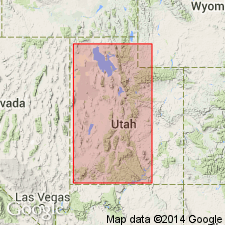
- Usage in publication:
-
- Toroweap Formation
- Modifications:
-
- Revised
- AAPG geologic province:
-
- Paradox basin
Summary:
Dolomite unconformably above the White Rim Sandstone in UT in the Capitol Reef area and unconformably above the Cedar Mesa Sandstone in the San Rafael area formerly assigned to the Kaibab Limestone is removed from the Kaibab and reassigned to the newly named Black Box Dolomite. Term Kaibab is restricted geographically to two areas of southwest UT discussed in this report--Marysvale and Beaver Dam. Kaibab considered to be of group rank in this report and is divided into: 1) Toroweap Formation (basal unit) and Fossil Mountain Limestone (top) at Marysvale; and 2) Seligman (base) and Brady Canyon Limestones, Woods Ranch Formation, and Kaibab Limestone ["when a unit is divided into two or more of the same rank as the original, the original name should not be used for any of the divisions." NASC, 1983, art. 19g.], and Plympton Formation (top) in the Beaver Dam Mountains. Black Box shown as equivalent to Kaibab of the Beaver Dam Mountains. Cross section. Permian age. [Intent or reason to modify rank of Kaibab not stated.]
Source: GNU records (USGS DDS-6; Denver GNULEX).
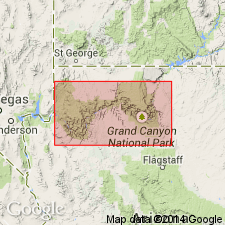
- Usage in publication:
-
- Toroweap Formation*
- Modifications:
-
- Revised
- AAPG geologic province:
-
- Plateau sedimentary province
Summary:
Toroweap Formation was assigned to Aubrey Group in earlier reports on the Grand Canyon region, AZ of the Plateau sedimentary province. Name Aubrey abandoned in this report. Basis for abandonment: 1) Supai, formerly the oldest formation in the Aubrey Group, was raised to group rank; 2) boundaries of Aubrey have been revised several times over the years; and 3) term Aubrey has fallen into disuse.
Source: GNU records (USGS DDS-6; Denver GNULEX).
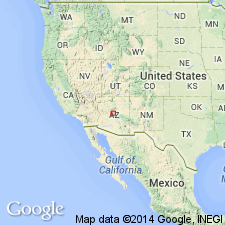
- Usage in publication:
-
- Toroweap Formation
- Modifications:
-
- Revised
- AAPG geologic province:
-
- Plateau sedimentary province
Summary:
Overlies and tongues into Coconino Sandstone. In Sycamore Canyon-Sedona area, Yavapai Co, AZ, Plateau sedimentary province, tongues into Cave Springs Member, newly named member of Coconino. Underlies Kaibab Formation unconformably. Cross sections. Nomenclature chart. Recognized west of a line that runs from Sycamore Canyon north through Marble Canyon of the Grand Canyon; line defined by a sharp facies change from Coconino-White Rim Sandstone to carbonate, sandstone, and red beds of Toroweap. Of Early Permian, Leonardian age.
Source: GNU records (USGS DDS-6; Denver GNULEX).
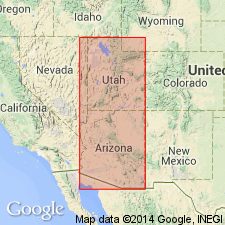
- Usage in publication:
-
- Toroweap Formation*
- Modifications:
-
- Overview
- Reference
- AAPG geologic province:
-
- Basin-and-Range province
- Plateau sedimentary province
Summary:
First published paper to describe (ascending order): Brady Canyon, and Woods Ranch Members of Toroweap. These members were named by Sorauf (1962) in an unpublished thesis. Seligman Limestone reduced in rank to Seligman Member, basal member of Toroweap. Toroweap divisible in northwest AZ west of a north-south line that extends generally west of Page and the Colorado River in Coconino Co, Plateau sedimentary province, south to Prescott, Yavapai Co in Basin-and-Range province. East of this line the members grade into dolomitic sandstones and dolomite of undivided Toroweap. Reference section designated and measured in sec 12, T33N, R9W east to top of Hurricane Cliffs, Mohave Co, where Toroweap is 429+ ft thick, and it overlies Coconino Sandstone and underlies Fossil Mountain Member of Kaibab Formation (redescribed). At reference section: 1) Seligman consists of 55+ ft of tan sandstone, white to pink gypsum and black dolomite; 2) Brady Canyon consists of tan, gray, brown, fossiliferous limestone, 191+ ft thick; 3) Woods Ranch consists of interbedded white gypsum, gray to black dolomite, yellow to brown sandstone, tan limestone, red siltstone, mudstone, and claystone 182 ft thick. Nomenclature chart. Of Early Permian, Leonardian age.
Source: GNU records (USGS DDS-6; Denver GNULEX).
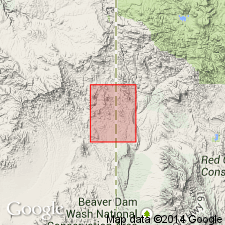
- Usage in publication:
-
- Toroweap Formation*
- Modifications:
-
- Areal extent
- AAPG geologic province:
-
- Great Basin province
Summary:
Mapped in east-central Lincoln Co., NV in the Great Basin province. Two members mapped --Brady Canyon, at base and Woods Ranch at top. Brady Canyon overlies Seligman Member and older parts of Toroweap. Woods Ranch underlies Fossil Mountain Member of Kaibab Formation. Of Early Permian, Leonardian age.
Source: GNU records (USGS DDS-6; Denver GNULEX).
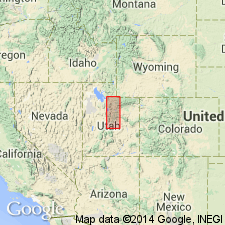
- Usage in publication:
-
- Toroweap Formation*
- Modifications:
-
- Areal extent
- AAPG geologic province:
-
- Great Basin province
- Wasatch uplift
Summary:
Extended into westernmost part of study area which includes Gunnison Plateau-Valley Mountain and Pavant Range-Canyon Range, Juab Co, UT, Great Basin province and Sanpete-Sevier Valley and Wasatch Plateau, Sanpete Co, UT, Wasatch uplift. Unconformably overlies Humbug Formation in Great Basin province area and unconformably overlies Redwall Limestone in Wasatch uplift area; conformably underlies Blackbox Dolomite throughout its occurrence in study area. Correlates with White Rim Sandstone to east and north. Early Permian age.
Source: GNU records (USGS DDS-6; Denver GNULEX).
For more information, please contact Nancy Stamm, Geologic Names Committee Secretary.
Asterisk (*) indicates published by U.S. Geological Survey authors.
"No current usage" (†) implies that a name has been abandoned or has fallen into disuse. Former usage and, if known, replacement name given in parentheses ( ).
Slash (/) indicates name conflicts with nomenclatural guidelines (CSN, 1933; ACSN, 1961, 1970; NACSN, 1983, 2005, 2021). May be explained within brackets ([ ]).

